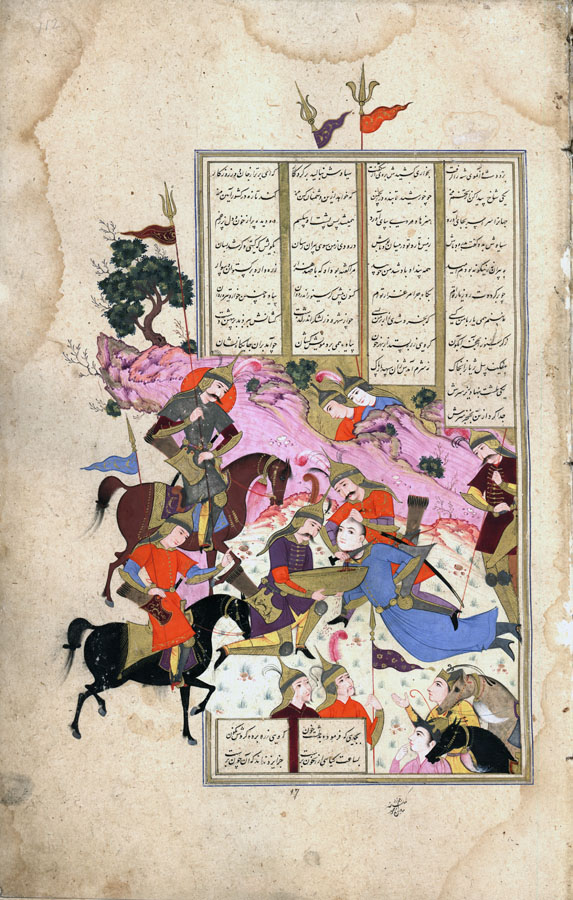Goruy Executes Siyāvoš
The subject is a popular choice amongst illustrations of the Shahnama. The main action is depicted at the center of the composition. Siyāvoš, his hands bound behind his back, is held firmly by the hair by the Turānian officer Goruy, who, with a knife provided by Garsivaz, is about to sever the head of Siyāvoš. Another Turānian soldier kneels before them with a shallow bowl to receive the head and the blood that is about to be spilt. The excution was ordered by the Turānian king Afrāsiyāb after Garsivaz had falsely accused him - Garsivaz was present at the execution, and it may be him that the artist intended, mounted, in the upper left. Two horses and grooms, their lower extremities cropped by the frame, wait in the lower right corner; they are, presumably, the mounts for the two executioners. Seven other Turānian soldiers observe the event from various locations. Two are standing, one holding a standard, in the lower left foreground, the lower portion of their bodies cropped by the frame. Another carrying a standard is mounted on horseback on the left side of the composition. On the extreme right is yet another standing soldier, and in the center background, beyond the crest of the hill, two more are peering over the ridge. The setting is a barren, sloping hillside with small tufts of grass dispersed evenly over its surface. The hillside rises to a rocky crest, not toward the back of the pictorial space, but rather upward to the left. It reaches a rocky pinnacle just beyond the frame at which point a small tree and several diminutive branches of vegetation grow.
There are four columns of text above the painting. One column is comprised of eleven lines, one column of nine lines, and two of eight lines each. At the bottom left corner are two more columns of text comprised of two lines each. A rectangular ruled frame encloses painting and text, except on the left side where it encloses only the text. Otherwise, the frame on the left side is non-existent and the painting spills into the left margin without restraint. Additionally, at the top, two standards violate the frame and protrude into the upper margin. The painting is signed in the lower margin, just to the right of center, in miniscule characters in Moʿin’s hand: raqam zad kamina moʿin-e moṣavver. The inscription is not dated.
For another version of this subject by Moʿin, see Ms.B, 2-320
Painting references:
Welch, AK4_1978, p.90, Ms.22, folio 112r (not ill.).
Text references:
Warner, II, pp.320-21; Mohl, II, p.327.
Robert Eng
Last Updated: June 29, 2011 | Originally published: June 29, 2011
